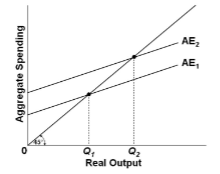Refer to the diagrams. Assuming a constant price level, an increase in aggregate expenditures from AE 1 to AE 2 would:


A. move the economy from A to C along AD 1 .
B. move the economy from C to A along AD 1 .
C. increase aggregate demand from AD 1 to AD 2 .
D. decrease aggregate demand from AD 2 to AD 1 .
C. increase aggregate demand from AD 1 to AD 2 .
You might also like to view...
Calculate the arc price elasticity of demand for wheat in the two situations below:
The Wheat Market Farmer Brown's Wheat Old price; $3.40/bu Old price; $3.40/bu Old quantity; 2.5 billion bu Old quantity; 28,000 bu New price; $3.20/bu New price; $3.20/bu New quantity; 2.525 billion bu New quantity; 35,000 bu Can you account for the difference in elasticities?
Scarcity is a problem:
a. measured by the amount of goods available. b. of the poor, but not the rich. c. because human wants are unlimited while resources are limited. d. only in industrialized economies.
Average fixed costs in the short-run:
a. increase as the quantity produced increases. b. decrease as the quantity produced increases. c. first decrease, then increase eventually as the quantity produced increases. d. first increase, then decrease eventually as the quantity produced increases.
A five-cent container deposit on bottles
A. Increases the price of recycled materials and thus discourages recycling. B. Increases the price of containers that do not use recycled materials. C. Has no impact on the price of recycled materials. D. Decreases the price of recycled materials and thus encourages recycling.